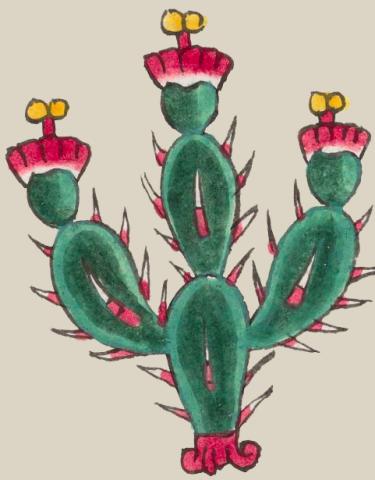Xoconochco (Mdz18r)
This simplex glyph for the place name Xoconochco features simply the cactus plant that produces the fruit called tuna in Spanish today (nochtli). The plant has a leader and two branches, each one with a flower on top, where the fruit would be produced. The cactus is painted a two-tone green (possibly meant to provide three-dimensionality). It has curling red roots showing, and lots of thorns, which are red at their base and white at their tips. The flowers are fairly detailed, green at the base, with petals that are white at the bottom and red at the top, and above that each flower has a red stamen with two yellow balls (anthers). The xocotl is not represented visually, nor is the -co locative suffix.
Stephanie Wood
Xocotl can refer to fruit in general or, more specifically, to a native plum tree (see below, right), which some call the "hog plum." Here, perhaps, it is not featured separately from the cactus because the nochtli was meant to be emphasized. But the yellow anthers on the cactus flower do appear somewhat like their counterparts on the representation of the xocotl tree elsewhere in the Codex Mendoza (below, right).
In some flowers, such as these, the anthers are rather pronounced. The anthers are the flower parts that produce and provide the pollen, which has the reproductive capacity that has been compared in Western cultures to semen.
Stephanie Wood
xoconochco. puo
Xoconochco, pueblo
Stephanie Wood
c. 1541, or by 1553 at the latest
Stephanie Wood
cactus, cacti, cactos, nopales, nopalli, tunas, espinas, nombres de lugares

xoco(tl), a native plum tree, https://nahuatl.wired-humanities.org/content/xocotl
noch(tli), cactus fruit, https://nahuatl.wired-humanities.org/content/nochtli
-co (locative suffix), in or at, https://nahuatl.wired-humanities.org/content/co
Codex Mendoza, folio 18 recto, https://digital.bodleian.ox.ac.uk/objects/2fea788e-2aa2-4f08-b6d9-648c00..., image 46 of 188.
The Bodleian Libraries, University of Oxford, hold the original manuscript, the MS. Arch. Selden. A. 1. This image is published here under the UK Creative Commons, “Attribution-NonCommercial-ShareAlike 3.0 License” (CC-BY-NC-SA 3.0).



